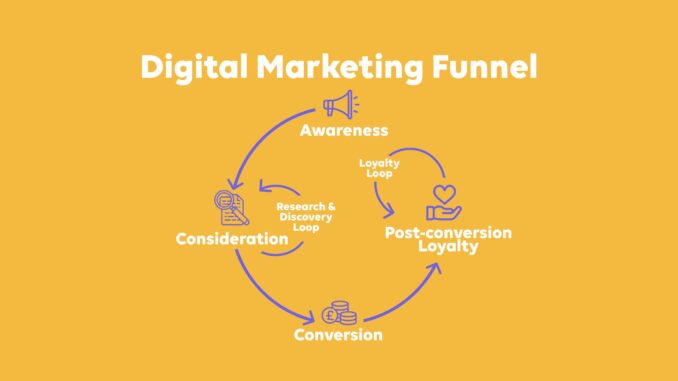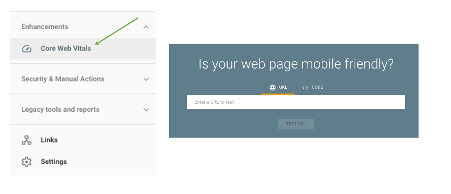
You’ve heard of the digital marketing funnel. But how can you use it effectively to make digital marketing strategies grow your business further.
What is the digital marketing funnel?
The digital marketing funnel has been around for years. It’s changed over time, but it’s now developed to include 5 stages. The important point to note here is that it’s very much a fluid process, rather than a rigid structure, and it can take time and investment to see this come to fruition.
- awareness – they see a brand or company
- discovery/research – they start digging around, understand the benefits and grow an interest
- consideration – they think about buying something
- conversion – they buy something
- post-conversion loyalty – they become a brand ambassador, and might drive you more business
This funnel was once only defined as having 3 stages, being ‘awareness’, ‘consideration’, and ‘decision’. And you might say these is just the typical stages of someone buying something. But that’s exactly why it matters. You can use this, now developed concept, to create a strong digital marketing campaign across your website and social media platforms.
Why should you care? An example of an effective funnel
Let’s put the digital marketing funnel into action so you can see how it subtly pushes someone who doesn’t know the name of your business to eventually become a customer. For example, imagine your business is a sports shoe shop, and ‘Sally’ signs up for another half marathon.
| What happens? | Funnel Phase |
|---|---|
| Sally remembers how tatty and worn out her running trainers are, so texts her running friend asking what trainers she wears and her friend recommends a few of her favourite brands, including yours | Awareness |
| Sally Googles 3 of those brands, including yours, and sees your Google Ad | Awareness |
| Sally wonders how much money she’ll have to fork out and Googles “how much do running trainers cost” and reads an article by your brand walking her through financial advice for quality trainers. She decides it’s worth the money because it’s a personal investment | Consideration |
| Sally scrolls through Facebook, sees your Ad, clicks it and sees positive reviews and comments on your company page | Consideration |
| Sally gets excited about crossing the finish line and Googles “best running trainers for me”, and finds an infographic that explains how to choose trainers depending on your running style, frequency, and type of terrain | Discovery/Research |
| Sally shares the link with her friend, and a week later, she Googles “running trainers for women”, sees your organic listing and clicks through | Discovery/Research |
| Sally reads that these trainers are specifically designed for longer distance runners, then finds the guide that shows her how to check they’re a good fit and sees they have a reasonable returns policy. | Discovery/Research |
| Sally easily finds the section on delivery times, and decides it’s quick enough | Discovery/Research |
| She finds her size and clicks ‘add to cart’, but then exits for now | Discovery/Research |
| She receives an ‘abandoned cart’ email, and re-opens the site. She sees a ‘10% off ends today’ pop up, and hits ‘complete transaction’ | Conversion |
What is involved in the stages?
Stage 1: Awareness
At this stage, people who don’t know about your company yet first become aware of your brand. This is where your new potential customer finds a problem, like Sally realising she’s signed up for a half marathon and her trainers are too old and worn out.
Or someone’s boiler breaking, or a couple having moved in and they realise they want to decorate first but don’t have the time to do it themselves, and it’s that first moment they hear of your company name. Whether that’s through a conversation with a friend, a social media post, an organic listing, or a PPC ad like the below.
Stage 2: Discovery/Research
This is where that someone starts seeing more of your brand name, in PPC advertisements, in organic listings, a local 3 pack like the one below. It might be on your actual website, or on social media, the list goes on. But they’re starting to develop an interest in how your company can solve their problem. Whether they’re looking for affordable, reliable half marathon trainers, or a trust-worthy boiler replacement or a local decorator they feel comfortable with.
This part can take time because it’s about building up trust in you as a company. If they buy from you, is their new purchase going to break easily, turn up late or just not be what it’s hyped up to be? This can take longer especially if it’s a higher cost buy. This potential customer wants to be 100% sure before they convert.
Stage 3: Consideration
This is where your potential customer has a significant interest in your brand, and they do want to buy from you. But something is holding them back. Maybe they’re not sure on the price, or they want to see that other customers are happy.
Stage 4: Conversion
This is where your potential customer makes the end purchase. They’ve grown aware of your brand and are convinced enough that you can help solve their problem.
They trust that the running trainers will be comfortable and practical enough for their half marathon. They trust that you’re the right experienced expert to replace your boiler. They trust that your decorator is on the same page as you and you’ll have a beautiful, but affordable new flat in next to no time.
So they make the purchase.
Stage 5: Post-Conversion Loyalty
If your converted customer has a positive experience from your brand, they become a brand ambassador for you. People talk about positive experiences, which means if you give good business, your new customers will naturally help grow your brand awareness.
They might leave a glowing review on your website or on your social media. They might follow your company page on social platforms, and even share, like or comment with positive responses. They might tell their friends and family about your company and why they liked you. This might have a ripple effect where the good news spreads, and a family member might search for your brand first the next time they’re in need of what you sell.
Or, if what you sell can be bought over and over, your new customer is more likely to return for a repeat purchase.
The content & marketing you need for each stage
Stage 1: Awareness
Did you know people in the UK spent just under 2 hours a day on social media in the third quarter of 2020? And over 6 hours a day solely using the internet on any device? That means get in front of your potential customer.
- Get mobile optimised using Google’s tool
- Be active on social media
- Post regular industry updates
- Publish information that’s genuinely helpful for your audience
- Don’t post random information
- Check your priority pages are optimised for organic search, so they show up and get the traffic they deserve
- Make sure your website runs smoothly and doesn’t break easily when it gets a higher amount of traffic, use Core Web Vitals in Search Console

Stage 2: Discovery/Research
In 2017, a study showed that 74% of consumers use search engines to find out more information, during this phase. This will undoubtedly have grown since then. In fact, 70% of people who buy something online use Google at the very least 2-3x to hunt for more info.
So, write for SEO. Create helpful creative content for those people to access, see and read. That could include ‘how to’ posts, or ‘best X for me’, or ‘how much does X cost’. This is where you need to create content on your website and any other platforms you use that answers peoples’ questions.
Give them the information they want in the most digestible form.
For example:
- Blog content that’s optimised and appears as a featured snippet (higher CTR) – how much does it cost to decorate my flat? See an example of ‘people also ask’ opportunities below
- Ebook that’s got an optimised landing page on your website and a link in your social bio – guide to plan decorating your new flat
- Infographic that’s accessible on your social media platforms & website – top 5 benefits of choosing the right decorator
- Google My Business listing that shows up for ‘local decorators’ – you’d need to set this up as part of a local SEO strategy
- Quick practical videos that put your product or service into action
- Informative product and category pages mentioning USPs
- Whitepapers with updated research and industry information
Stage 3: Consideration
Your potential customer is growing interested. But they need to be really convinced you’ve got the solution to their problem.
- Display positive GDPR compliant customer testimonials on your website, from real people
- Put your offers and discounts on your website and make it stand out
- Include demonstrative videos about what you sell
- Use your USPs to play on your audience’s pain points
Stage 4: Conversion
They’re hooked, but they’re not ready to buy yet. Consider the following:
- Set up ‘abandon cart’ emails
- Add successful case studies to your website
- Add clear, quality, relevant images to your website
- Include a FAQ for your customers on your website
Stage 5: Post-Conversion Loyalty
This phase is just as important, even if your customer has now converted. If you nourish that new relationship, they’re more likely to see that you truly care and value them as a customer. They may become that brand ambassador, which leads to more potential business.
- Give some ‘free’ information or giveaways
- Provide loyalty offers
- Have a strong customer service team in some form
- Good post-purchase communication
- Exclusive newsletters
How to measure the success
You’ve got all of the above in place. So how do you know it works? How can you go about checking this to track how successful each part is, so you know what you need to improve going forwards, if there is?
Here are some pointers to ask. You’ll need to get set up in Google Analytics to ensure tracking is properly working. You can measure page by page performance by any given time period.
- Does your conversion rate and revenue go up?
- Does your bounce/exit rate go down?
- Have you seen an increase in any of your traffic, including Social, Paid, Organic or Referral?
- Have you seen an increase in organic keyword rankings?
- Have you seen a higher length of time in your Session Duration?
- Have you seen more content downloads for your e-book?
- Have you seen more engagement and followers on your social media?
- Have you seen a better CTR on your marketing emails?
Now you should feel more confident in how to maximise the digital marketing funnel for your campaigns to grow. You might also be interested in these from our digital marketing blog:
While you’re here, catch us on Facebook, Twitter, Instagram and LinkedIn too with the latest information.
The post How The Digital Marketing Funnel Works For Your Business appeared first on Kaweb.

Leave a Reply